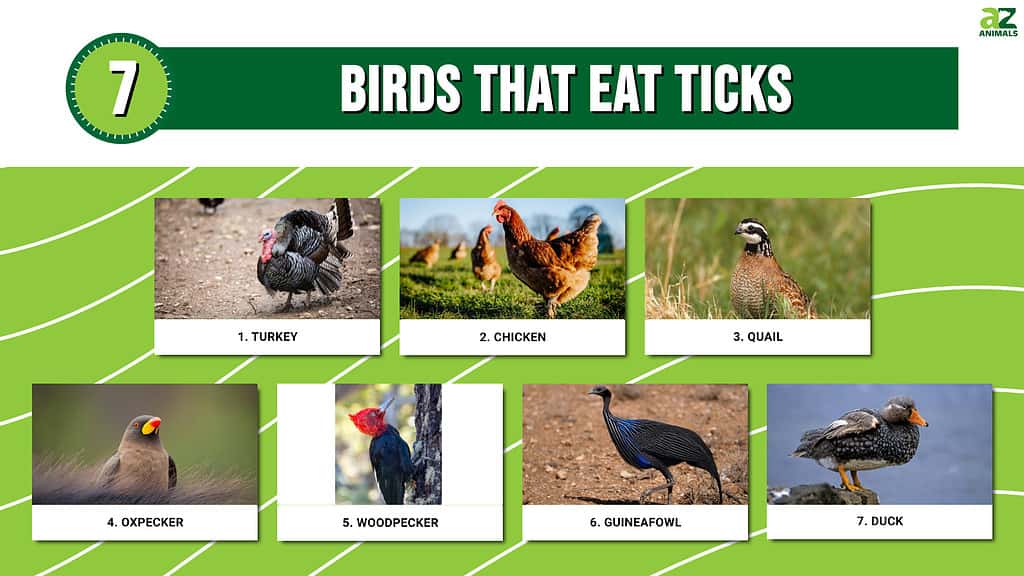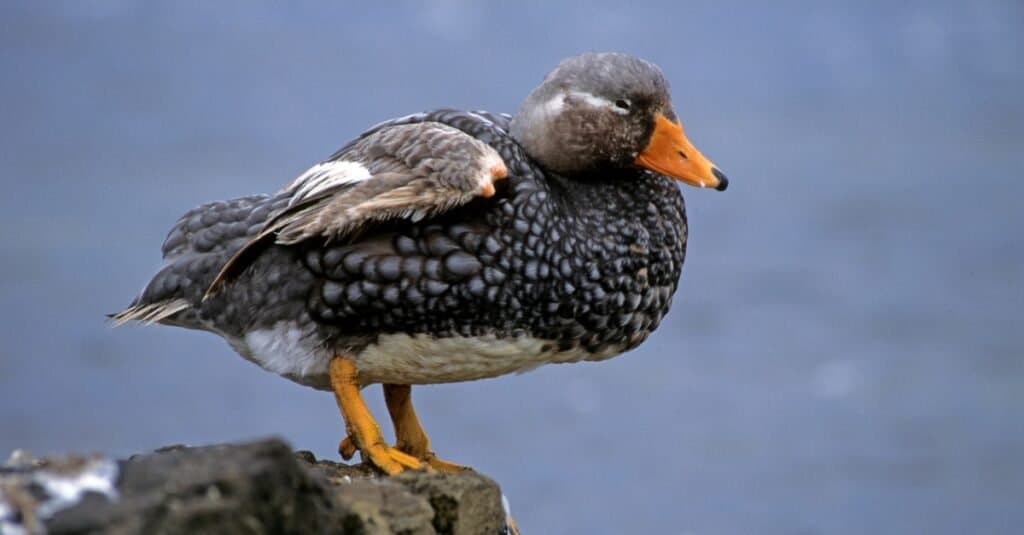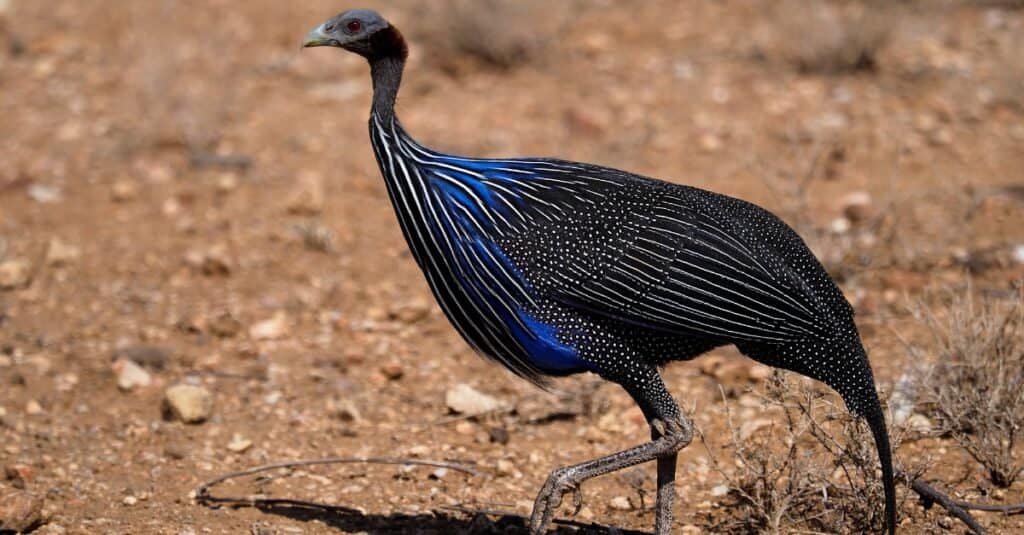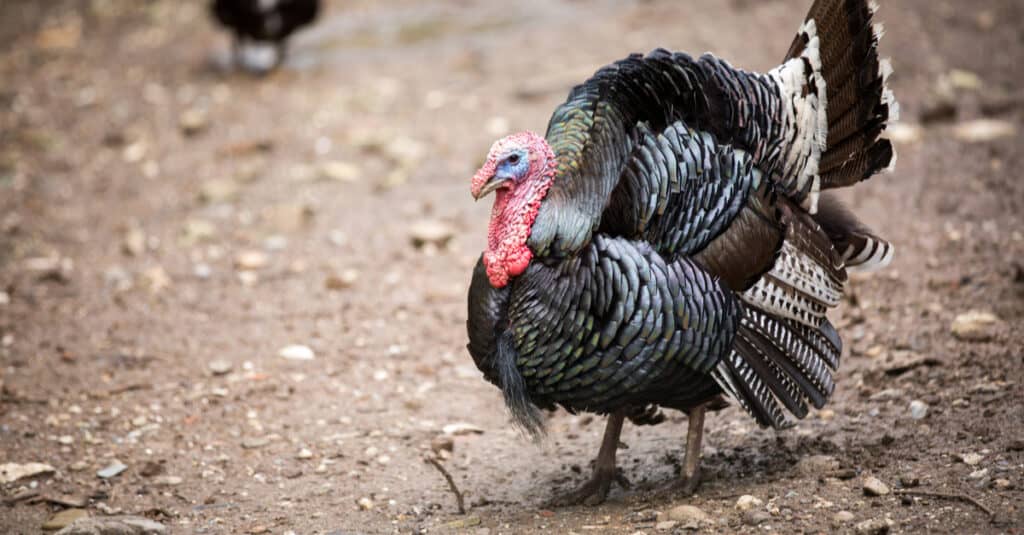Few insects fill people with as much horror as ticks. These parasitic arachnids may only measure a few millimeters long, but they can do a lot of damage if left unchecked. Ticks feed off the blood of animals and can carry a host of nasty viruses and pathogens. A few tick-borne diseases include typhus, spotted fever, Q fever, and — most commonly — Lyme disease. As such, ticks often earn a deservedly bad rap. Many products exist to help prevent you from getting tick bites, including sprays, tick-repellent clothing, and more. That said, there exist a number of natural methods to reduce tick populations. One of the most well-known is to introduce animals that eat ticks into the area. Perhaps the most prolific are the numerous birds that eat ticks.
In this article, we’ll discover 7 different birds that eat ticks. In particular, we’ll focus on what makes these birds such great predators of ticks. After all, you’ll want to know which birds target ticks so you can make sure to keep them close by! With that said, here are 7 birds that eat ticks.

#7. Duck

Ducks can pick up a large number of ticks when they forage in long grass.
©iStock.com/Michel VIARD
Ducks are among the most widely distributed waterfowl in the world. You can find them in almost every corner of the world, from streams and coastlines to backyard farms. Mostly omnivorous, ducks eat a wide variety of plant and animal matter from aquatic plants to fish and insects. Along with eating mosquitos, flies, and other pests, ducks also consume large amounts of ticks. They typically pick up ticks when walking through long grass, and can eat massive numbers in a single day. While ducks will not completely eat all of the ticks in an area, they can significantly keep down tick numbers. It’s no wonder that many farmers keep ducks close by to help reduce the risk of ticks and the diseases they carry.
#6. Guineafowl

Guineafowl pick up ticks while following animal herds.
©Erni/Shutterstock.com
Also known as pet speckled hens, guineafowl originally hail from Africa. One of the oldest ground-feeding birds, domesticated guineafowl now range throughout the world. In the wild, guineafowl follow animal herds and consume bugs in animal manure and carcasses. While not known as good parents, guineafowl rank among the most effective birds that eat ticks. In fact, farmers have used guineafowl for generations as a natural tick repellent. The birds will pick up ticks from herd animals nearby, as well as from tall grass. Once a guineafowl spots a tick, it will pick it up with its beak and swallow the insect whole. Over the course of a year, a single guineafowl may eat thousands of ticks.
#5. Woodpecker

Woodpeckers use their long tongues to pick up ticks off of trees.
©iStock.com/nikpal
The woodpecker is one of the most easily recognizable birds in the world, and not just because of the cartoon character, Woody. Woodpeckers make a distinctive knocking sound when they beat their beaks against trees in search of insects. They tend to live in forests and woodlands, although some also live in grasslands and deserts. While some woodpeckers get in trouble for making holes in trees and houses, others earn people’s praise. To be precise, many people appreciate woodpeckers because of their ability to reduce tick populations. Woodpeckers use their long, sticky tongues to pick up ticks crawling on tree trunks and bushes. On some occasions, woodpeckers will also use their beaks to pierce ticks’ bodies. As such, woodpeckers possess several methods to eradicate ticks.
#4. Oxpecker

Oxpeckers pick ticks off the backs of their animal hosts.
©iStock.com/RudiHulshof
The oxpecker belongs to the Buphagidae family of songbirds. These small birds are endemic to sub-Saharan Africa and tend to live in grassland habitats. The two known species each possess unique red or yellow eyes, as well as large red or yellow beaks. They get their name from their unusual habit of perching on the backs of large mammals. It is not uncommon to see them perched atop zebras, antelopes, rhinos, or wildebeests. Oxpeckers graze for insects on top of their animal hosts, and will particularly feed on the parasites feasting in open wounds. In particular, oxpeckers make short work of ticks feeding on their animal hosts. Along with ticks, oxpeckers will also target lice and fleas, and can deftly remove buried insects with their sharp beaks.
#3. Quail

Quail eat a large number of ticks while hunting for insects hiding in the grass.
©iStock.com/twildlife
A common gamebird, the quail belongs to the family of ground-feeding birds Galliformes. They range throughout most of the world and live in a variety of habitats, but usually grasslands and open spaces. Traditionally hunted as game birds, many farmers now also raise quail for commercial production. Quail eat a wide variety of insects and plants but rank among the most prolific birds that eat ticks. When hunting for ticks, they will stick their heads into tall grass or bushes and pluck the offending bugs from leaves. Due to their abilities, they can greatly reduce the number of ticks in a yard or field.
#2. Chicken

The chicken is one of the most common domesticated animals on the planet and a prolific eater of ticks.
©iStock.com/Sonja Filitz
The chicken is one of the most commonly domesticated animals on the planet. There exist more than three times as many chickens as people, with a total world population of over 20 billion. People raise chickens for both meat and eggs, and they feature important in a number of cultures. Some people also keep chickens as pets, and it’s easy to see why given their eating habitats. Chickens will eat just about anything they can catch, although seeds and insects make up a large portion of their diet. They will make short work of ticks, which makes them quite popular with farmers and herders. Since ticks live off the blood of other animals, farmers rely on chickens to keep ticks off their animals. When grazing, chickens use their sharp beaks to peck at the ground and pick up ticks and other insects.
#1. Turkey

Turkeys eat a wide variety of fruits, nuts, and seeds, as well as ticks.
©Matthew Clemente/Shutterstock.com
The turkey is one of the largest birds in the Galliformes family. Endemic to North America, turkeys are easily identifiable due to their size, sound, and distinctive wattle. Two species currently exist, the wild turkey and the ocellated turkey. That said, turkeys also commonly feature in commercial farming, particularly for their meat but also for their eggs. They typically live in woodland areas, but you can also find them in grasslands or swamps. Turkeys eat a wide variety of foods, particularly fruits, nuts, seeds, and insects. However, it’s their appetite for insects, especially ticks, that makes them particularly popular among farmers. Turkeys eat copious amongst of ticks and may consume tens of thousands over a lifetime.
Summary of 7 Birds That Eat Ticks
Here’s a recap of the 7 tick-eating birds that we took a close look at:
| Number | Bird | Ticks As Food |
|---|---|---|
| 1 | Turkey | Appetite for ticks makes them popular among farmers and may consume tens of thousands over a lifetime |
| 2 | Chicken | Use sharp beaks to peck at the ground and pick up ticks when grazing |
| 3 | Quail | Stick their heads into tall grass or bushes and pluck ticks from leaves |
| 4 | Oxpecker | Remove ticks from the top of their animal hosts |
| 5 | Woodpecker | Use long, sticky tongues to pick up ticks on tree trunks and bushes and use their beaks to pierce ticks’ bodies |
| 6 | Guineafowl | Pick up ticks from herd animals and tall grass, and swallow ticks whole |
| 7 | Duck | Typically pick up ticks when walking through long grass |
Thank you for reading! Have some feedback for us? Contact the AZ Animals editorial team.








